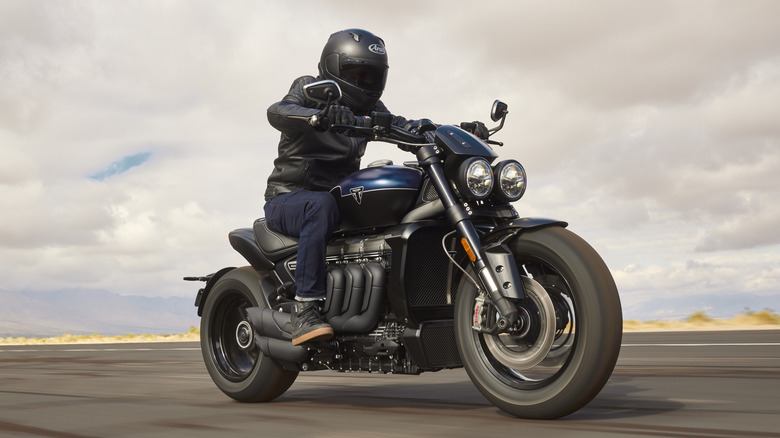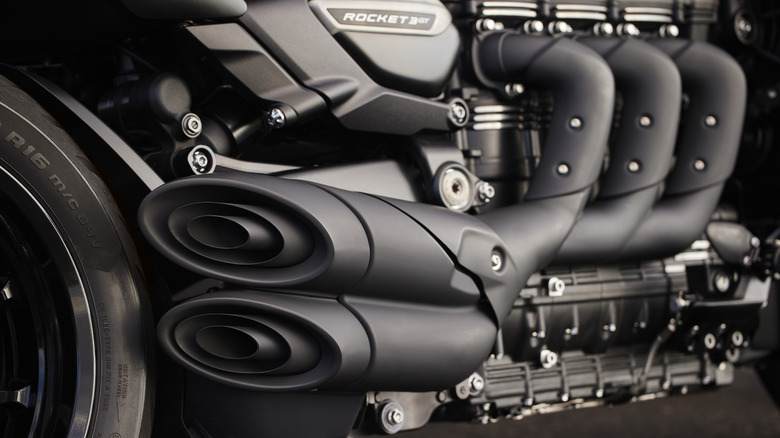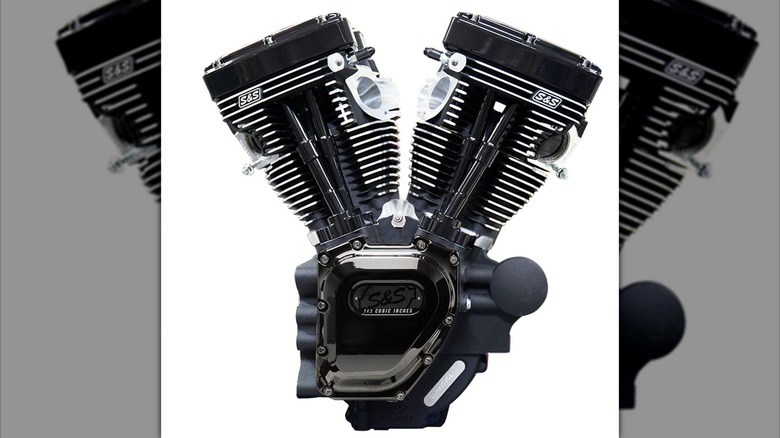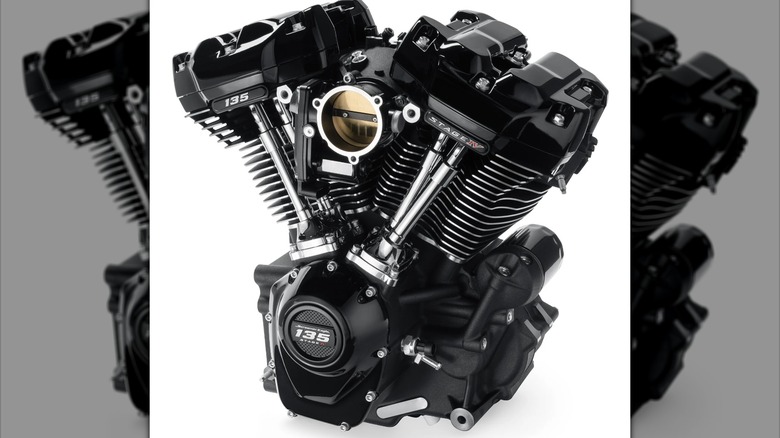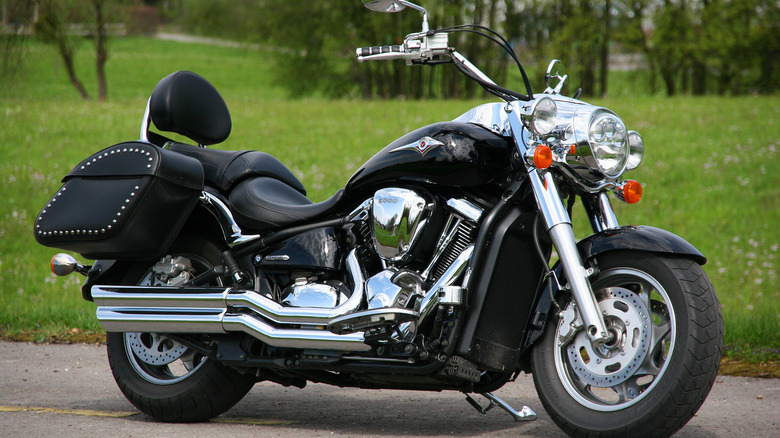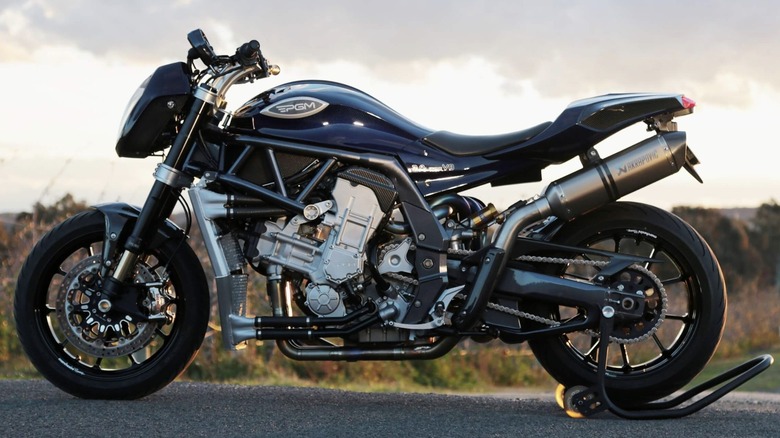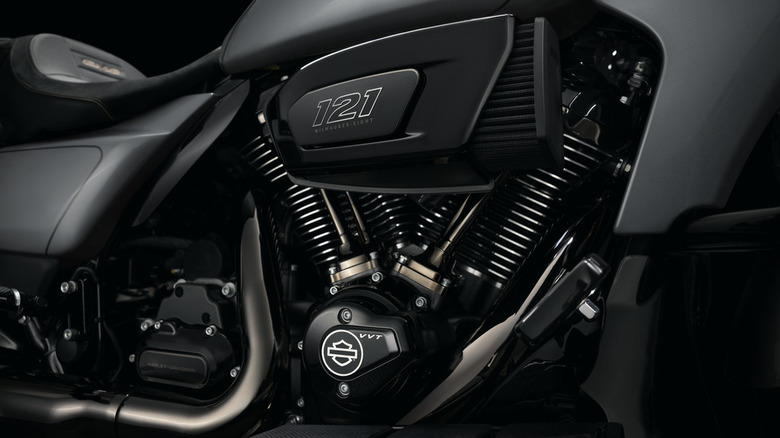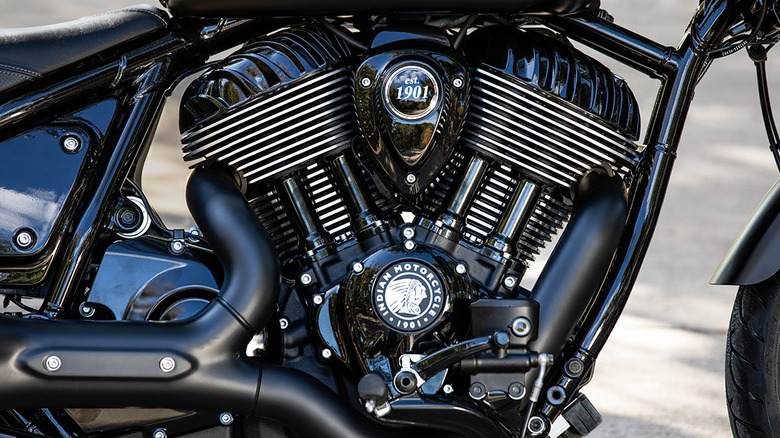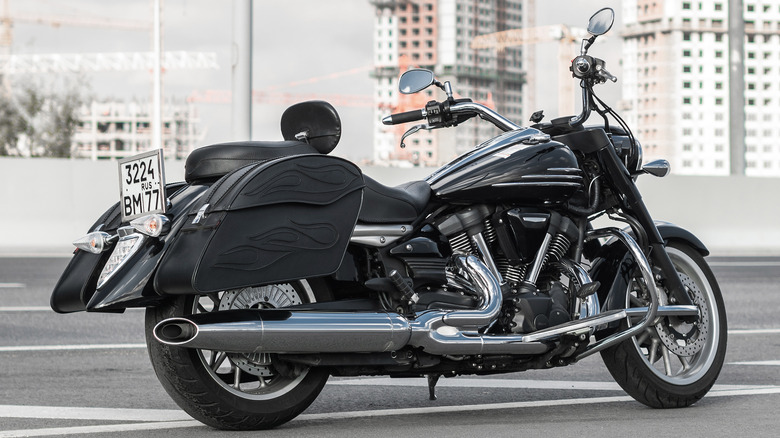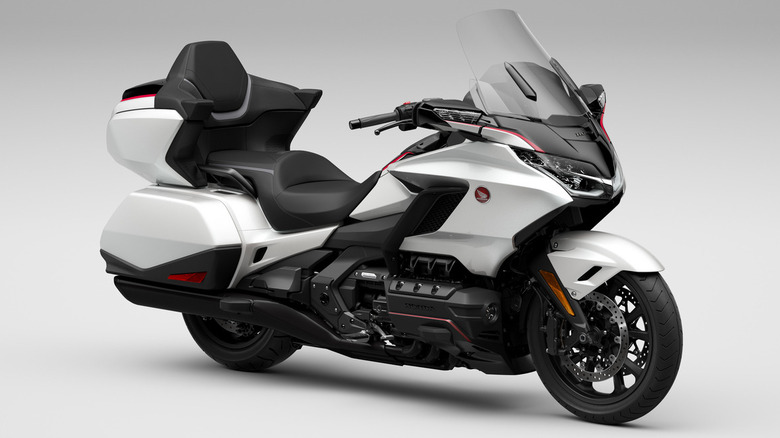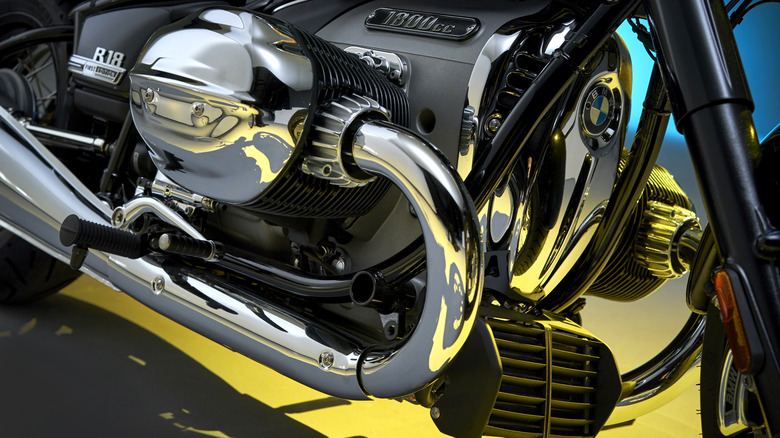10 Of The Biggest Motorcycle Engines Ever Made
Many of us likely associate motorcycles with nimble handling, convenience, and the ability to squeeze through all but the worst traffic. While those are all valid reasons to love and enjoy motorcycles, many companies have gone down the opposite route by building big, burly cruisers with massive engines. These beasts favor power above all else, offering the rush of low-end torque that only large-displacement engines can provide.
Of course, big bikes, like big cars, aren't always for everyone. They can be impractical and tough to handle, and give up the relatively easy handling and great maneuverability of smaller bikes. Still, even if you're not interested in riding them, we think that huge-displacement motorcycle engines — and the bikes they power — are still worthy of appreciation, if only for how over-the-top they can be.
So, let's celebrate the biggest and the baddest of the motorcycle world by going through 10 of the biggest motorcycle engines ever made to find out all about them. From massive 2.5-liter inline threes to crazy eight-cylinder engines, there's a lot more to the world of motorcycle engines than you may have realized.
2,458 cc Triumph Rocket 3 engine
Triumph's Rocket bikes have been associated with huge engines ever since the British marque introduced the model back in 2003. The Rocket III, as it was known then, packed a 2,294cc three-cylinder engine. This engine held the crown for the largest-displacement production motorcycle engine for more than a decade, sitting at the top of the pile until Triumph one-upped itself with the all-new but similarly named Rocket 3 – note the Arabic numerals — in 2019.
The Rocket 3 debuted with an all-new 2,458cc three-cylinder engine that produced even more power and torque than the previous incarnation. For context, this equates to around 820 cubic centimeters per cylinder, larger than most entire motorcycle engines. The new 2.5-liter engine made 164 horsepower and 163 lb-ft of torque, a noticeable improvement on the Rocket III's 148 horsepower and 147 lb-ft of torque. These numbers put the Triumph Rocket 3 engine in the upper echelon of bike engines, with its torque output in particular decimating even those of high-end superbikes like the Aprilia RSV4 Factory and its 92 lb-ft of torque.
That's enough torque to propel the $24,000 Rocket 3 from 0 to 60 mph in 2.73 seconds, setting a new record for Triumph production motorcycles in the process. No mean feat, considering the Rocket 3's roughly 650-pound dry weight. Triumph hasn't stopped there, either, as the Rocket 3 Storm R and GT models introduced in 2024 bring the power output up to a superbike-bothering 180 horsepower and cement its place as one of Triumph's best motorcycles ever.
2,343cc S&S T143 crate engine
You may think that crate engines are solely the preserve of cars and trucks, but you'd be wrong. You can get crate engines for motorcycles, too, and one of the largest ones available is S&S's 2,343cc T143 engine. The T143 is a replacement for Harley-Davidson Big Twin engines from 1999 to 2017, specifically those in the company's Touring and Dyna motorcycles.
Despite being significantly larger than the stock 1,700cc Twin Cam 103 engine in those bikes, the T143 drops into stock Harley-Davidson chassis with no modifications required. It's a race engine focused on pure performance at the cost of drivability and comes from the factory with a range of trick S&S parts, including in-house cylinder heads, crankcases, a high-flow oil pump, a custom high-output camshaft, and performance rocker arms.
The result is a gut-wrenching 162 rear-wheel horsepower and 151 lb-ft of torque, capable of powering a 2015 Harley-Davidson Road Glide and rider down the quarter-mile in under 10 seconds. Of course, that much performance doesn't come cheap — you're looking at around $11,000 for the engine alone, not including the fuel and ignition systems you'll need.
The T143 is intended for race use only and isn't legal on pollution-controlled vehicles, so you're not likely going to get to cruise around with this monster between your legs. Still, if you're building a Harley-Davidson for the drag strip and have money to burn, this might just be the engine for you.
2,212cc Harley-Davidson Screamin' Eagle 135 Stage IV
Crate motorcycle engines may not be as common as those for cars, but don't tell that to Harley-Davidson. The iconic American brand makes two Screamin' Eagle crate engines, the Milwaukee Eight 131 and the larger, burlier Screamin' Eagle 135 Stage IV, the latter of which we'll look at here.
Harley-Davidson offers the 135 cubic inch (2,212cc) Screamin' Eagle 135 Stage IV as a bolt-in replacement for the Milwaukee Eight engines in 2021 and newer Harley-Davidson Touring bikes, both air/oil and twin-cooled. As the name may suggest, the Screamin' Eagle 135 comes with a range of Harley-Davidson's Screamin' Eagle performance parts, including CNC-ported cylinder heads, a high-lift camshaft, high-compression forged pistons, high-flow fuel injectors, and a new 68-mm throttle body.
Combine all of these parts with the Screamin' Eagle 135 Stage IV's massive displacement and you get the largest and most powerful street-legal crate engine Harley-Davidson has ever built. The Stage IV makes 130 horsepower and 143 lb-ft of torque at the rear wheel, a significant chunk more than the 115 horsepower Milwaukee Eight 121 VVT engine in bikes like the 2024 CVO Street Glide. The best part? You won't even need to spend all that much to get your hands on one. The air/oil and twin-cooled versions of the Screamin' Eagle 135 Stage IV can be had for just under $8,000.
Even better, Harley's crate offering is 49-state EPA compliant, so most Harley owners in the U.S. will be able to enjoy one if they so desire — unless you live in California.
2,053cc Kawasaki Vulcan 2000 V-twin engine
Kawasaki's Vulcan 2000, which the Japanese company made from 2004 to 2010, was the culmination of nearly three decades of engine displacement wars between motorcycle companies. Suzuki's 1400 Intruder and Kawasaki's Vulcan 1500 kicked things off in 1987, but it wasn't until Kawasaki introduced the Vulcan 2000 in 2004 that these motorcycles broke past the hallowed 2.0-liter mark.
The Vulcan 2000's 2.0-liter V-twin engine made a healthy 104 horsepower and 130 lb-ft of torque when it debuted in 2004, rising to 116 horsepower and 141 lb-ft of torque by the time Kawasaki discontinued the bike. Despite its relatively modest power output compared to newer engines, the Vulcan 2000 engine's 4.1-inch bore and 4.9-inch stroke mean it still ranks as the largest-ever V-twin installed in a production bike, with only crate engines from the likes of S&S and Harley-Davidson boasting larger displacements.
That modest power output means that the Vulcan 2000 was never a high-performance motorcycle, even back in the 2000s. The debut model's 820-pound curb weight made for a modest performance, with Motorcycle Cruiser recording a 12.43-second quarter mile time in testing. While power and torque did improve over the years, the minor increases aren't likely to have changed much. Despite that, the engine fit the cruiser bill perfectly, with that same review pointing out the engine's plentiful torque and smooth power delivery — arguably more important than quarter-mile times for prospective cruiser owners.
[Image by Christian Ammerling via Wikimedia Commons | Cropped and scaled | CC BY-SA 3.0]
1,996cc PGM V8 engine
Yes, you read that right — a V8 in a motorcycle. Unlike brands that use V8 LS crate engines in their bikes – Boss Hoss, for example — the V8 in the PGM V8 was a bonafide motorcycle engine, if not necessarily a conventional production motor.
The PGM V8 was the brainchild of former F1 and World Superbike mechanic Pat Maloney. Maloney first experimented with combining two 750cc Kawasaki ZX-7RR engines to create a 1.5-liter V8 but eventually settled on the Yamaha YZF-R1's 998cc four-cylinder engine instead, given its similar dimensions to the Kawasaki engine. The final result was a V8 engine with Yamaha cylinder banks joined at 90 degrees via a flat-plane crankshaft housed in a custom engine case.
A crazy engine setup doesn't always mean crazy power, but the PGM V8 delivered on that front. PGM claimed 334 horsepower and 157 lb-ft of torque measured at the countershaft sprocket, more powerful than many of the most powerful motorcycles currently in production. Pair that with a 530-pound curb weight, and you have the makings of a real monster.
Given its extreme performance, sheer audacity, and exorbitant AU$130,000 pre-order price in 2018, it likely won't surprise you that the PGM V8 didn't quite set the world on fire. We're not sure if PGM is still making V8s, but its engine means the bike deserves a place in history — even if it was only ever a brief flash in the pan.
1,977cc Harley-Davidson Milwaukee-Eight VVT 121
Harley-Davidson's Milwaukee-Eight engine launched in 2016 as the ninth generation of its storied Big Twin engines. This all-new design was available in three variants, with the 1,870cc Twin-Cooled Milwaukee-Eight 114 the largest of the three. The 114 held the top spot for a few years before Harley introduced the 1,923cc Milwaukee-Eight 117 for the 2018 model year CVO motorcycles. However, Harley-Davidson wasn't done with the Milwaukee-Eight, one-upped itself again in 2023 by unleashing the Milwaukee-Eight VVT 121.
Like its predecessors, the 1,977cc Milwaukee-Eight VVT 121 engine powers the latest and greatest in Harley-Davidson's line of CVO motorbikes. However, the newest member of the Milwaukee-Eight family introduced several new features to the Milwaukee-Eight family, including liquid-cooled cylinder heads and a new variable valve timing system. These improvements, alongside the bump in displacement and higher 11.4:1 compression, helped the 121 to produce 115 horsepower and 139 lb-ft of torque, up from the 117's 103 horsepower and 126 lb-ft.
The Milwaukee-Eight VVT 121 elevated the 2023 Harley-Davidson CVO bikes, with outlets such as Cycle World particularly enjoying the engine's better performance, revvier nature, and improved throttle response. The Milwaukee-Eight VVT 121's story doesn't end there — in 2024, Harley-Davidson introduced a High Output version of the Milwaukee-Eight 121 for the 2024 CVO Road Glide ST. This hotter version makes 127 horsepower and 145 lb-ft of torque, putting even more power at riders' fingertips and bridging the gap between Harley's production engines and crate engines like the Screamin' Eagle 135 Stage IV.
1,890cc Indian Thunderstroke 116
Indian Motorcycle has been around for more than a century, with all manner of motorcycle engines – large, small, and everything in between — coming out of its factories over those years. Chief amongst them is the 1,890cc Indian Thunderstroke 116, the most recent and largest-displacement version of its modern-day air-cooled V-twin engine to date.
The Thunderstroke was the first engine the revived Indian brand manufactured in 2013 and was the brand's first clean-sheet design in 70 years. The first version was the 1,811cc Thunderstroke 111, but the larger Thunderstroke 116 would eventually replace it as the stock engine for select Indian Chief, Chieftain, Springfield, and Roadmaster models for the 2020 model year. The Thunderstroke 111 makes 119 lb-ft of torque in Indian Chief bikes, while the larger Indians get a slightly higher 126 lb-ft of torque.
Interestingly, Indian doesn't disclose horsepower numbers for its engines, but that's where third-party testing comes into the picture. Cycle World took a 2021 Chieftain Limited on their dyno and measured just about 85 rear-wheel horsepower from the engine, which is not the most power you'll ever see from a bike, but certainly adequate for cruisers and baggers such as the Chieftain Limited. Besides, it's the Thunderstroke 116's torque output that really matters here, and there's plenty of it — even if Cycle World's 116 lb-ft is slightly short of Indian's claimed numbers.
1,854cc Yamaha XV1900A V-twin
Kawasaki wasn't the only Japanese motorcycle manufacturer trading blows in the high-displacement cruiser wars of the 1990s and 2000s. Yamaha had its own big boy offering in the 1,854cc air-cooled V-twin engine powering its Harley-Davidson-styled XV1900A cruiser, which is known as the Star Roadliner in the U.S.
The XV1900A's engine actually started life as an even larger unit, but testers found the prototype unwieldy and not enjoyable to ride. So Yamaha went back to the drawing board, scaling the engine back to reduce the bike's height and overall weight. Still, while Yamaha may have ceded the displacement crown to the 2.0-liter monster powering Kawasaki's Vulcan 2000, the XV1900A's motor wasn't a slouch. With a 9.5:1 compression ratio helping it produce rear-wheel numbers of 91 horsepower and 114 lb-ft of torque, the engine's throttle response and performance were good enough for outlets such as RoadRunner to put it on par with the larger Kawasaki.
However, the Yamaha's standout feature was undoubtedly the EXUP valve. Without getting too technical, Yamaha's EXUP featured power valves in the exhaust that opened and shut dynamically with the engine's RPM, altering the exhaust's supposed length to increase torque or horsepower as needed across the rev range. The XV1900A was the first implementation of the EXUP system in a cruiser, having previously only featured on the company's sport and superbikes, like the YZF-R1.
1,833cc Honda Gold Wing flat-six
Touring motorcycles are almost always on the bigger side, and few come bigger than Honda's nigh immortal Gold Wing. Launching with a water-cooled four-cylinder engine all the way back in 1975, the Honda Gold Wing would go on to define the luxury touring motorcycle segment, comfortably selling more than 500,000 units over its lifespan.
While it started with a modest 1.0-liter engine, the decades since have seen the Gold Wing's power plant not only increase in size but add a couple of cylinders to the equation, too. The final result? The 1,833cc flat-six that's powered all Honda Gold Wings since 2018. The flat-six configuration itself isn't new to the Gold Wing, having debuted in 2001, but this most recent flat-six features redesigned internals and a more compact layout along with more power, to the tune of 125 horsepower and 130 lb-ft of torque.
Despite having gobs of power and torque on tap, the flat-six is far from an aggressive beast. Cycle News reviewed the 2018 Gold Wing and noted the engine's smooth power delivery (aided by the seven-speed automatic transmission) and noticeable midrange power, both crucial for a fully-laden luxury tourer like the Gold Wing. Besides, with many Honda Gold Wing models having curb weights of around 850 pounds, all that power is more of a necessity and less of an invitation to get rowdy with the throttle.
1,802cc BMW Big Boxer
BMW Motorrad has its hands in many pies, offering everything from urban mobility scooters to high-performance superbikes. However, one type of motorcycle was conspicuous in its absence from the company's product range for most of the 21st century — the cruiser. Sure, there was the R1200C, but that ceased production in 2004. It wasn't until 2020 that the world would see a new BMW cruiser in the R 18.
BMW pitched the R 18 as a blend of old and new, and its monster 1,802cc flat-twin boxer engine — the largest boxer engine BMW has ever built — served as an example of this. BMW has a history with boxer engines going back to 1932's R 32, and the R 18's 1.8-liter engine could be seen as a culmination of nine decades' worth of engine development. The R 18's engine retains old-school BMW boxer details such as the overhead valve configuration and separate transmission housing but with a modern power output of 91 horsepower and 116 lb-ft of torque, which was enough for BMW to claim that it was the most powerful mass-produced two-cylinder boxer engine ever.
The Big Boxer powers six different R 18 models, starting from the $15,000 First Edition and going up to the luxury-minded R 18 Transcontinental, which starts at $24,000. No matter which model you go for, though, you'll have the same beefy low-end torque available at a flick of your wrist, along with that signature boxer engine thrum.
